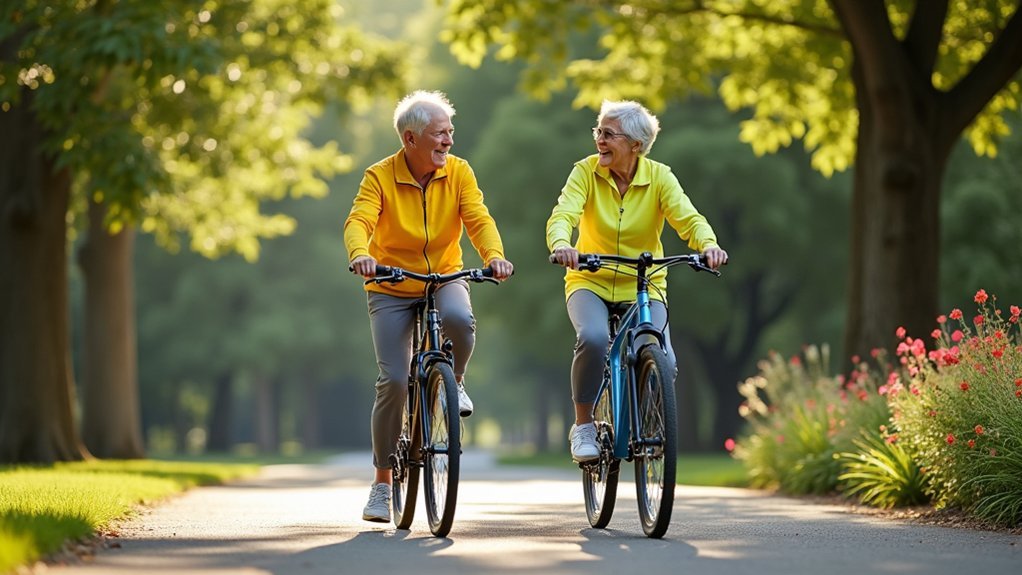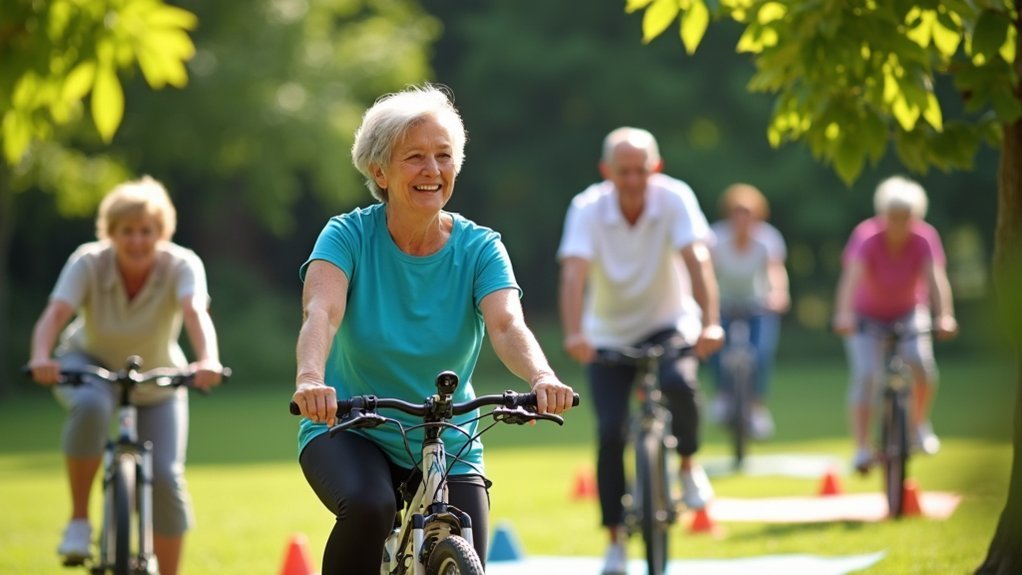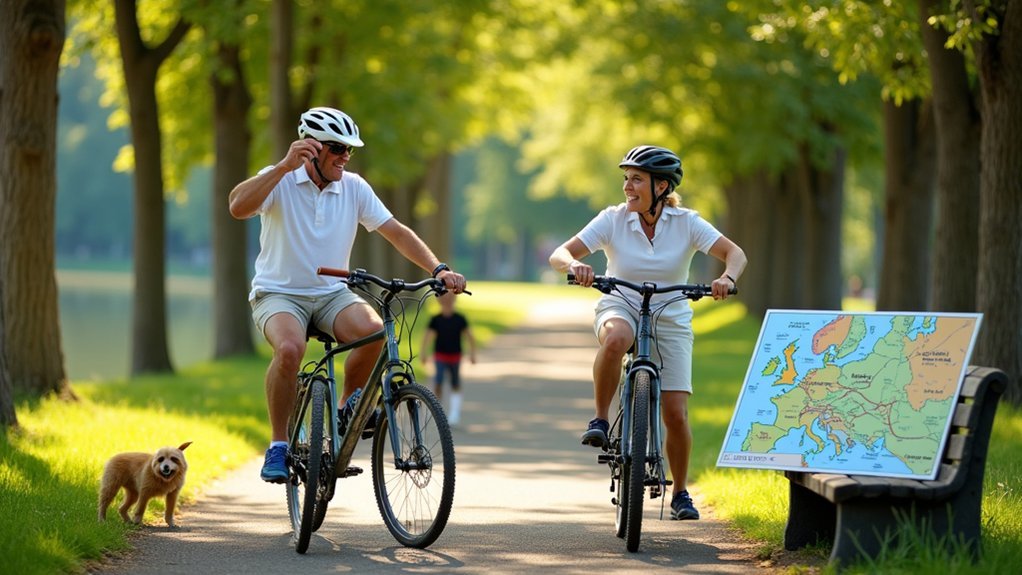Seniors can begin cycling safely by choosing the right bike with a step-through frame and proper seat height. Start with strength and balance exercises off the bike to build confidence. Invest in essential safety gear including a well-fitted helmet and high-visibility clothing. Begin with short rides on flat, low-traffic paths and gradually increase distance by 10% weekly. E-bikes offer an excellent option for those needing assistance while maintaining cardiovascular benefits. The journey ahead offers both freedom and health advantages.
Choosing the Right Bike for Your Body and Needs

Success in cycling begins with selecting the right bike. For older riders, comfort and accessibility are paramount. When shopping, make certain the seat sits at hip level to provide proper leg extension while pedaling. This simple adjustment prevents knee strain and improves overall efficiency.
Consider frames with low step-through designs that make mounting and dismounting easier—a vital feature as you age.
Don’t skip the test ride; try several models to find one that feels stable and comfortable under your unique body type.
Look for bikes with adjustable handlebars that allow for an upright position, reducing strain on your back and neck.
Don’t overlook e-bikes, which offer pedal assistance for hills and longer rides, making cycling more accessible and enjoyable for seniors with varying fitness levels.
Essential Safety Gear for Senior Cyclists
Safety on two wheels requires three essential elements: proper equipment, visibility, and comfort. As you begin your cycling journey, invest in a well-fitted helmet that sits one to two fingers above your browline, providing vital protection against head injuries.
Don’t underestimate the importance of high-visibility clothing with bright colors and reflective materials to guarantee motorists can see you, especially in low-light conditions. To ride safely, equip your bike with white front lights and red rear lights for additional visibility during early morning or dusk rides.
Consider wearing gloves to improve grip and reduce hand fatigue, giving you better control while cycling.
Complete your safety gear with protective eyewear that shields your eyes from wind, debris, and harmful UV rays.
Building Strength and Balance Before Your First Ride

With the right safety gear secured, your body now needs preparation for the physical demands of cycling. Start by gradually incorporating strength training exercises like leg lifts and squats to build the leg power you’ll need for pedaling. These exercises don’t need to be strenuous—even gentle repetitions can make a difference.
Building cycling strength isn’t about intense workouts—even gentle, consistent training prepares your body for the road ahead.
Complement your routine with balance exercises such as standing on one foot or basic yoga poses. These will improve your stability and confidence on a bike, greatly reducing fall risks.
Consider low-impact activities like swimming or walking to boost your cardiovascular health without stressing your joints.
If you’re concerned about balance, try starting with a three-wheel bike for extra stability. Remember to set realistic goals and celebrate small victories—your cycling journey is a marathon, not a sprint.
Overcoming Fear and Rebuilding Confidence
Although the physical aspects of cycling require preparation, the mental hurdles can be equally challenging for seniors returning to biking after years away. Overcoming fear starts with acknowledging it’s both natural and justified—your concerns about falling aren’t irrational.
To rebuild confidence:
- Start with a three-wheel bike that eliminates balance concerns while you redevelop your cycling skills.
- Practice balance exercises off the bike first to strengthen your core stability.
- Set small, achievable goals—perhaps riding for five minutes in a safe environment.
- Be patient with yourself—remember that muscle memory fades but can be rekindled.
Don’t rush the process. Your confidence will grow as you gradually confront and overcome each anxiety, making cycling enjoyable rather than intimidating again.
Starting Small: Planning Your First Routes

Once you’ve rebuilt your confidence, selecting the right routes becomes essential for your cycling journey. As a first-time rider, prioritize flat, traffic-free areas like parks or dedicated bike paths that offer both safety and enjoyment.
Seek out gentle, car-free spaces for your initial rides—these sanctuaries build skill while preserving peace of mind.
Begin with short rides of just 15-20 minutes, then gradually increase your distance as your endurance improves. Your body needs time to adjust to this new activity.
Plan routes with convenient rest stops where you can hydrate and recover—these breaks are vital during longer outings.
Consider using cycling apps or maps to identify quiet streets and bike-friendly zones in your area.
Always listen to your body while riding; it’s perfectly acceptable to modify your route or cut a ride short if you’re feeling uncomfortable or fatigued.
Proper Hydration and Nutrition for Senior Cyclists
While planning safe routes forms the foundation of your cycling journey, proper nutrition and hydration will fuel your success on those routes.
As a senior cyclist, your body needs specific support to maintain energy and performance during rides.
Stay on top of your cycling nutrition and hydration with these essential practices:
- Drink at least 8 ounces of water every 20-30 minutes during your ride, even if you don’t feel thirsty.
- Pack nutrient-dense snacks like bananas or trail mix to maintain steady blood sugar levels.
- Include electrolyte-rich drinks or supplements to prevent cramping, especially in warm weather.
- Fuel up before riding with a balanced meal containing carbohydrates, protein, and healthy fats.
Listen to your body’s signals and adjust your intake accordingly to prevent fatigue and enjoy longer rides.
Weather Considerations and Seasonal Riding Tips
When cycling as a senior, your safety and enjoyment depend greatly on adapting to weather conditions and seasonal changes.
If you’re over 50, avoid riding during extreme heat to prevent dehydration and heat exhaustion. On cold days, layer your clothing strategically, paying special attention to hands and feet to ward off hypothermia.
Rainy conditions considerably increase fall risks, so consider postponing your ride or using fenders and waterproof gear for better traction. On windy days, choose sheltered routes and reduce your speed to maintain balance.
Seasonal riding tips include selecting well-maintained paths in winter to avoid ice patches and scheduling early morning summer rides to escape peak heat.
Finding Cycling Communities for Older Adults
Connecting with other cyclists your age can transform your riding experience from a solitary activity into a social adventure.
Your local cycling clubs likely offer senior-specific groups that match your pace and endurance level, providing built-in motivation and safety in numbers.
You’ll find these communities not only share valuable riding tips but also create lasting friendships centered around your new healthy habit.
Group Benefits
Beyond the physical health advantages, cycling offers seniors a remarkable opportunity to build meaningful connections through dedicated communities. When you join a senior cycling group, you’ll discover benefits that extend far beyond the exercise itself.
- Social motivation – Fellow riders provide encouragement and accountability, making it easier to maintain your cycling routine even when motivation wanes.
- Enhanced safety – Group rides create visibility and provide assistance if you experience mechanical issues or need help traversing challenging routes.
- Skill development – You’ll learn valuable techniques and tips from experienced cyclists who understand the unique needs of older riders.
- Goal setting – Organized events through cycling communities give you achievable targets to work toward, celebrating milestones with others who share your passion.
Try Local Clubs
Three excellent pathways exist for seniors seeking to join the cycling community.
First, research cycling clubs in your area that offer age-specific group rides, providing you with a built-in support system of peers at similar fitness levels.
Second, attend club-sponsored workshops where you’ll gain valuable cycling tips on safety, technique, and equipment maintenance specifically relevant to older riders.
Third, join a cycling event designed for beginners to meet potential riding companions while exploring routes in a supervised setting.
Local clubs typically offer graduated programs that help you build confidence at your own pace.
You’ll benefit from the collective knowledge of experienced cyclists while forming friendships that keep you motivated.
The social connections you make often become the driving force behind maintaining this healthy habit long-term.
Understanding E-Bikes as an Adaptive Option
E-bikes offer you a perfect gateway into cycling with their pedal-assist technology that reduces strain on joints while still providing cardiovascular benefits.
You’ll want to select models with step-through frames and adjustable assist levels that match your mobility needs and comfort requirements.
As your confidence grows, you can gradually adapt to longer rides by increasing speeds and distances at your own pace, making cycling an enjoyable and sustainable activity regardless of physical limitations.
E-Bike Basics
The electric revolution in cycling has created an adaptive pathway for seniors looking to stay active. E-bikes offer pedal-assist technology that complements your natural cycling motion while reducing strain on joints and muscles. This makes cycling accessible regardless of your current fitness level.
With these motorized companions, you’ll enjoy:
- Extended range capabilities of 20-50 miles per charge, allowing you to explore further without exhaustion.
- Adjustable assistance levels that let you gradually build strength and confidence.
- Design features like step-through frames that make mounting and dismounting easier.
- Health benefits backed by research showing improved cardiovascular function among older riders.
The beauty of e-bikes lies in their versatility—you can control how much or little assistance you need as your comfort and abilities evolve.
Selecting Right Models
Now that you’re familiar with e-bike basics, finding your perfect match becomes your next adventure.
As a senior cyclist, prioritize models with low step-through frames that make mounting and dismounting easier on your joints. These designs eliminate the need for high leg lifts that could challenge your balance.
Look for e-bikes with adjustable pedal-assist levels, allowing you to gradually increase intensity as your confidence grows. The battery range matters too—most offer between 20-70 miles per charge, giving you plenty of freedom for exploration without anxiety.
Your e-bike should adapt to your changing abilities over time. Research shows seniors who choose e-bikes are more likely to maintain regular cycling habits, boosting cardiovascular health while reducing physical strain when tackling hills or longer distances.
Adapting To Changes
As our bodies change with age, embracing adaptive technologies becomes essential for maintaining an active lifestyle. E-bikes represent an excellent shift option for seniors returning to cycling, offering motorized assistance while still providing valuable exercise.
You’ll find e-bikes can transform your riding experience through:
- Pedal assistance that compensates for physical limitations, letting you ride longer distances without excessive strain.
- Higher average speeds with less effort, making your cycling adventures more enjoyable across varied terrains.
- Easy mounting/dismounting features like step-through frames that accommodate balance or mobility concerns.
- Gradual strength building as you ride more frequently, using the e-bike’s assistance as a bridge back to regular cycling.
This technology enables you to maintain independence while adapting to your body’s changing capabilities.
Maintaining Proper Posture to Prevent Injury
Proper posture while cycling represents one of the most critical yet often overlooked aspects of riding safety for seniors.
As you begin cycling, focus on keeping your back straight and shoulders relaxed to distribute weight evenly across your spine. Position your saddle at hip height to guarantee proper leg extension during pedaling, protecting your knees from unnecessary strain.
Keep your elbows slightly bent while gripping the handlebars—this simple adjustment absorbs road shock and reduces upper body tension.
Don’t forget to engage your core muscles throughout your ride, as this stabilizes your body and greatly reduces the risk of developing lower back pain.
Your helmet should fit snugly without tilting, not only for protection but also to encourage a more upright posture that prevents neck strain during longer rides.
Recovery Techniques for Aging Muscles
Recovery after cycling deserves special attention for seniors, much like maintaining correct posture during rides.
Your aging muscles need more time to heal and rebuild compared to younger cyclists, but proper recovery techniques can support both muscle health and cardiovascular health.
As we age, our bodies require additional recovery time—but with proper techniques, both muscle and heart health can thrive.
- Rest properly – Allow at least 48 hours between intense cycling sessions to give your muscles adequate healing time.
- Stretch thoroughly – Incorporate post-ride stretching to enhance flexibility and reduce tightness in worked muscles.
- Engage in active recovery – Try gentle yoga or swimming on rest days to promote blood circulation without straining muscles.
- Use recovery tools – Foam rollers and massage techniques help break down muscle knots and improve circulation.
Don’t forget to stay well-hydrated and consume protein-rich foods to support muscle repair after your rides.
Setting Realistic Goals and Tracking Progress
You’ll find greater satisfaction in your cycling journey by celebrating small milestones, like completing a new route or riding for five additional minutes without stopping.
Create a simple progress chart where you can visually track improvements in distance, duration, or challenging terrain conquered over time.
These tangible records of your achievements will boost your confidence and help you adjust your goals as you become more comfortable on your bike.
Measuring Small Wins
Success in cycling as a senior begins with celebrating the small victories along your journey. When you start slow and recognize incremental improvements, you’ll build confidence that sustains your cycling habit. Measuring small wins isn’t just motivating—it provides tangible evidence of your progress.
- Track physical improvements by noting when you can ride longer distances or navigate turns with greater confidence, which indicates enhanced leg strength and balance.
- Maintain a cycling journal to document rides, feelings, and challenges, helping you identify patterns in your progress.
- Use apps like Strava to log rides and monitor distance milestones.
- Celebrate achievements daily, whether completing a ride without discomfort or successfully exploring a new route.
Progressive Challenge Charts
Creating a progressive challenge chart serves as a powerful tool for seniors beginning cycling adventures. You can design a simple chart that tracks small, achievable improvements in your cycling journey.
Start by mapping out weekly goals that increase the intensity of your rides in manageable increments—perhaps adding 5 minutes to your ride time or tackling a gentle slope you’ve been avoiding.
Your chart might include columns for distance, duration, terrain difficulty, and how you felt afterward. Aim to increase these metrics by just 10% each week, allowing your body to adapt safely.
Remember to reassess regularly and adjust your challenges based on your comfort level. This visual representation of progress not only motivates you to continue but also helps prevent overexertion by keeping improvements gradual and sustainable.
Adapting Your Cycling Routine as You Age
While cycling remains an excellent activity throughout life, your approach needs thoughtful adjustment as you age. Your first riding experiences after returning to cycling should focus on building confidence rather than distance or speed. Listen to your body’s signals and adjust accordingly.
Cycling excellence continues at any age—adapt your approach, build confidence first, and let your body guide the journey.
- Embrace gradual progression – Increase duration and intensity slowly, allowing your body time to adapt and build endurance safely.
- Incorporate strength training – Add exercises that maintain muscle strength and balance alongside your cycling routine.
- Choose appropriate routes – Opt for low-impact paths and consider an e-bike if needed to enhance enjoyment.
- Prioritize balance practice – Regularly work on stability exercises to reduce fall risks and rebuild confidence on your bike.
Maintain ongoing communication with healthcare providers about any physical changes to guarantee your cycling plan remains appropriate.
Frequently Asked Questions
How to Start Cycling as a Senior?
You’ll want to choose a bike that fits properly, wear a helmet, start with short rides on flat terrain, learn road rules, practice signaling, and consider joining a cycling group for support.
Is 70 Too Old to Start Cycling?
No, 70 isn’t too old to start cycling! You’re never too old to enjoy the benefits of cycling. Many seniors begin at your age and thrive with proper equipment and a gradual approach.
What Is the 75 Rule in Cycling?
The 75 rule means you’ll want to keep your heart rate at 75% of your maximum (220 minus your age). For a 60-year-old, that’s around 120 beats per minute for ideal training benefits.
How Long Should a 70 Year Old Ride a Bike?
As a 70-year-old, you’ll want to start with 15-30 minute rides, 2-3 times weekly. You can gradually increase duration as your fitness improves, but always listen to your body and take recovery days between sessions.
In Summary
Cycling isn’t just for the young—it’s a wonderful way to maintain fitness, independence, and joy at any age. By selecting the right equipment, preparing your body properly, and approaching the journey with patience, you’ll discover newfound freedom on two wheels. Remember, it’s never too late to start cycling. Take it one pedal stroke at a time, and you’ll soon be enjoying the road ahead.





Leave a Reply